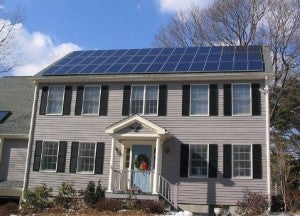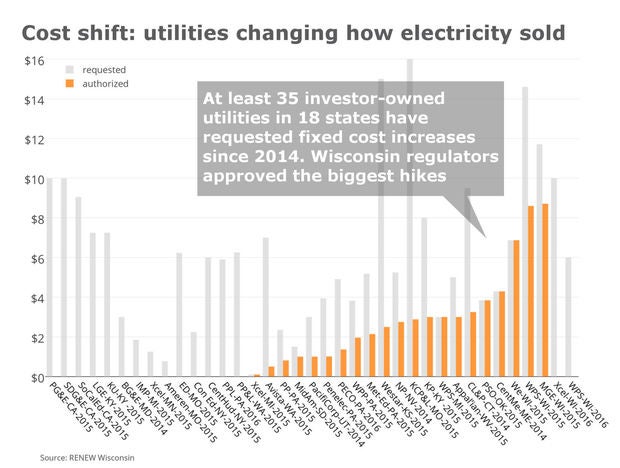 A recent study by the Lawrence Berkeley National Laboratory (LBNL) concludes that the way a utility charges customers can greatly influence whether they will install solar panels. It is a timely analysis because utilities across the country are redesigning their rate structures to accommodate our changing electricity system, which is becoming cleaner and more efficient than ever before.
A recent study by the Lawrence Berkeley National Laboratory (LBNL) concludes that the way a utility charges customers can greatly influence whether they will install solar panels. It is a timely analysis because utilities across the country are redesigning their rate structures to accommodate our changing electricity system, which is becoming cleaner and more efficient than ever before.
What’s unfortunate is that some utilities are intentionally trying to destroy customers’ incentive to install solar panels. Why? Because rooftop solar reduces shareholder profits and revenue for utilities.
Solar Electric Power Association (SEPA), a solar industry trade group, reports that in 2014, residential customers installed solar panels at an astounding 36 percent growth rate compared to 2013. But the LBNL study says the rate design changes now being proposed by utilities across the country could slash solar panel growth up to 60 percent. Clearly, poorly designed rate changes could devastate the potential for solar panels to help transform the electricity sector. Regulators should not let this happen.
Utilities have the opportunity to change their rate design to provide incentives for more solar adoption while also recouping investments and properly balancing their books.
Rate design 101
Rate design sounds like a complex topic, but it’s really quite simple. The term refers to how the utility arranges or “designs” the monthly bill for using electricity. At one extreme, a utility could charge a flat amount, or “fixed charge,” for customers to use an unlimited amount of electricity during the month.
At the other extreme, the utility could charge a rate for each unit of electricity used, known as a “variable charge.” In this scenario, the cost per-unit doesn’t change each month, but the amount of electricity consumed can vary greatly – and so can the utility bill.
In reality, utilities don’t use either one of these extremes. Instead, they use a combination of a monthly fixed charge and a variable charge. In theory, the fixed charge is supposed to cover some portion of the utility’s fixed costs for serving the customer, like building transmission lines and maintaining other elements of the grid’s infrastructure. Although the variable charge doesn’t change very often, the amount of electricity we use each month can change dramatically – with the highest usage occurring when we crank up our air conditioning and heater to stay comfortable.
Today, utilities recover most of their costs through the variable charge. The utilities’ playbook for halting loss of revenue from the growth of solar is to switch to fixed charges. It’s easy to see how this would harm solar panel customers. 
If the bill is based almost entirely on a variable charge, then a customer can install solar panels to reduce the amount of electricity needed from the utility – greatly reducing the customer’s monthly electricity bill. But if the bill is entirely based on a fixed charge, then solar panels wouldn’t change the bill at all. Customers would pay the same monthly fixed charge regardless of how much electricity they saved by installing solar panels.
[Tweet “Utilities’ rate designs can help or harm solar adoption”]
The bottom line on rate design
Admittedly, the answer to a well-designed electricity rate requires more than simply looking at how much of the bill is recovered through a fixed charge versus a variable charge. Regulators should consider whether the utility offers net metering, which allows solar customers to get paid for providing excess electricity to the grid, and time-variant pricing, a rate structure that reflects the true price of electricity, which varies by time of day and year. Regulators are also experimenting with demand charges for residential customers – where the customer would pay a fee based on how much their usage contributes to the utility’s peak usage. One thing is clear: regulators need to reject the utilities’ knee-jerk approach of just raising the monthly fixed charge.
Instead, regulators must consider other rate design factors and develop a balanced solution that gives the utility a fair opportunity to recover its costs, while also providing both solar and non-solar customers a way to pay their fair share of using the electric grid. Utilities should not be allowed to discriminate against solar customers by including demand charges that other residential customers are not required to pay.
Regulatory officials must stop utilities from adopting rate designs that harm customers who own solar panels. This is the right path for transforming into a fair, modern, low-cost, clean electricity system.
Photo source: Wikimedia Commons/Gray Watson
Graph source: The Chippewa Herald/Power Shift: Utilities, Regulators Changing How Customers Pay for Power









